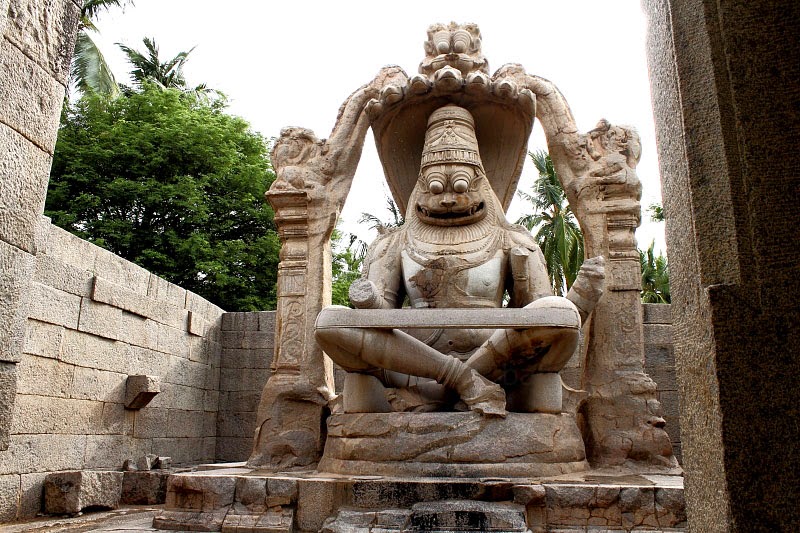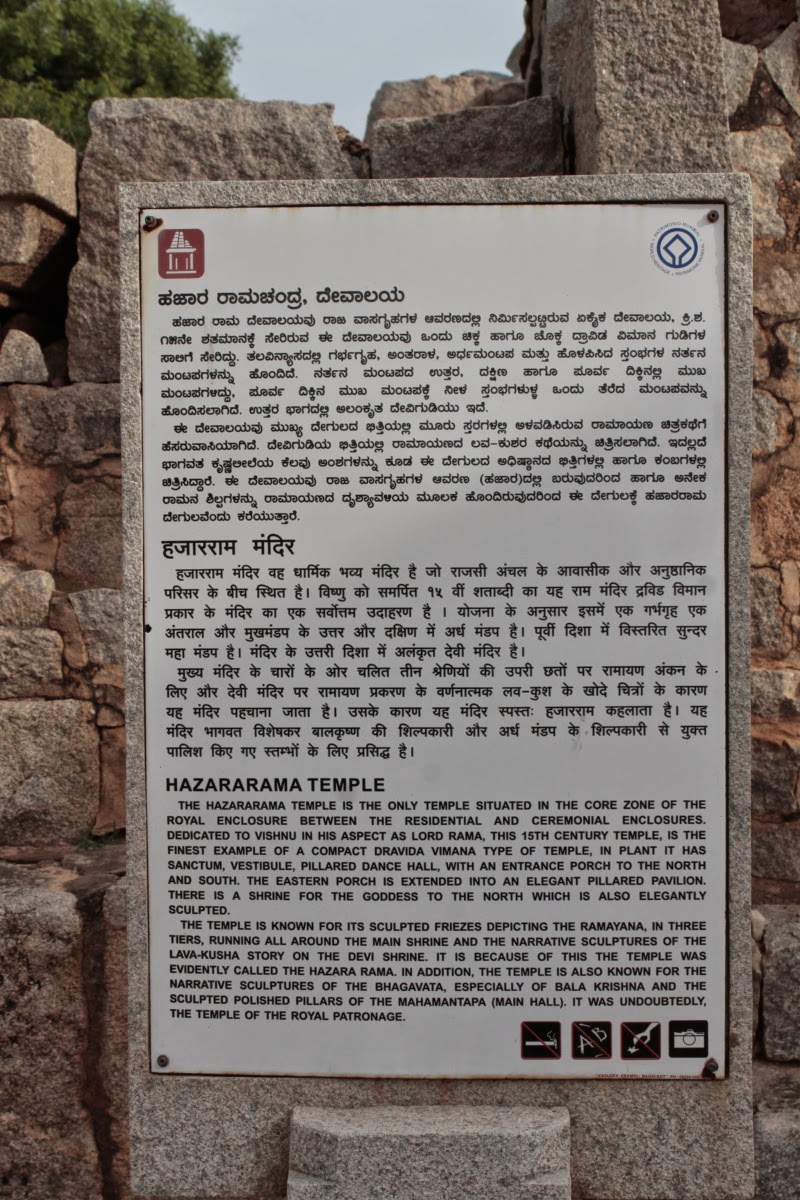Virupaksha Temple, one of the oldest functional temples on earth
After a date with River Nila in 2012 and the journey in search of the cloven Budha along the backwaters of Alleppy in 2013, they regrouped in summer of 2014.
The boulder lands of Hampi by the banks of River TungaBhadhra was a perfect excuse for the re union.
Tower of Virupaksha Temple
From the ambitious city of Bengaluru busy hatching its grandiose plans to raise itself as an international business hub, at a distance of approximately 350 km lies in ruins Hampi, the capital of the once mighty Vijayanagara empire. Sincere and commendable attempts by ASI of renovations notwithstanding, it still remains a lost city, a leftover skeleton of its magnificence of yore.
Those rare tourists who veer off from the otherwise busy tourist circuits of India might as well have trespassed into an Indiana Jones movie studio. Boulders of all sizes and conceivable shapes are strewn around with careless precision of a toddler who has been playing with its monster toy blocks. Stare hard enough and you can see Harrison Ford from behind one of those huge,centuries old rocks trying to squeeze his way out to safety just before closing credits start rolling in.
The sight of those king size rocks clinging on to one another so precariously makes one feel that all it needs on any given day is a gentle nudge by a wet Thungabhadhrian breeze - may be with a coded message from the 14th century- to dislodge one weak link and trigger a chain reaction of inter galactic proportions.
That hasn't happened yet.
The imaginary ligaments that hold together the star rocks continue to prove strong enough to withstand the onslaught of time and other invaders. Cemented together by secrets of the Vijayanagara empire, stories about the Rayas, of their valour, celebrations, bloodshed and victories, laughter echoed from the courts enthralled by the likes of Tenali Raman, the boulder lands of Hampi is where history and geography lie intertwined in a petrified embrace even as the Tungabhadhra moves on perennially with a knowing half-glance.
Step back into the realm of myth and the mindscape suddenly widens and becomes more colourful. Valmiki staged the entire Kishkintha Kanda of Ramayana in and around Hampi. This is where Hanuman is believed to have been born, brought up and stood for Rama. Some even refer to this place as maternal home of Bhoodevi, mother earth.
More recent and reliable documents provide ample proof to confirm that as capital of Vijayanagara empire, Hampi has been a great center of culture, trade and architecture. (As if the exquisite temples and the remains of the market places aren't loud enough to assert that.)
For all its yearning to be at the center of international business, modern day Bengaluru would be thrown into a bout of inferiority complex induced depression as and when it comes to know of the stature good old Hampi enjoyed a few centuries ago.
Abdur Razzak Samarkhandi (1413-1482), ambassador of Persian emperor Mirza Sharukh to Calicut writes:
" The city of Bidjanagar [Vijayanagar] is such that the pupil of the eye has never seen a place like it, and the ear of intelligence has never been informed that there existed anything equal it in the world"
"..the jewellers sell publicly in the bazaars pearls, rubies,emeralds, and diamonds. In this agreeable locality, as well as in the king's palace, one sees numerous running streams and canals formed of chiselled stone, polished and smooth."
Ugra Narasimha
Nicolo dei Conti, an Italian visited Vijayanagar in 1420 shortly after the accession of King Deva Raya II. His stories were recorded by Poggio Bracciolini, the Pope's secretary.
"The great city of Bizenegalia [Vijayanagara] is situated near very steep mountains (sic). The circumference of the city is sixty miles; its walls are carried up to the mountains and enclose the valleys at their foot, so that its extent is thereby increased. In this city there are estimated to be ninety thousand men fit to bear arms"
Duarte Barbosa, a cousin of Magellen who visited Vijayanagar between 1504-1514 writes that the "kingdom of Narsinga" exported iron, spices, drugs,myrabolans, and imported horses and pearls.
"There is an infinite trade in this city.. In this city there are many jewels which are bought from Pegu and Celani (ceylon), and in the country itself many diamonds are found, because there is a mine of them in the kingdom of Narsinga..."
Muhammad Qasim Hindu Shah, popularly known as Firishta has written extensively about the Vijayanagar empire. So has the Portugese traveler and horse trader, Fernao Nuniz who visited Vijayangara between 1535 and 1537.
More of Hampi, Vijayanagara and the Rayas to follow after further visits to the lost empire. Till then, a few images that attempt to convey what they realised during the visit :
Hampi is in its details.
Vitthala (Vishnu) Temple
Stone Chariot , Vittala Temple
Entrance of Vitthala Temple , with the remains of Lamp Pillar in the fore ground
Tower of Vitthala Temple
Ruins of Vitthala Temple
Vitthala Temple, architectural influences
Vitthala Temple: Strangely attired horse trader from distant lands
Market place, Vitthala Temple
Shiva Temple within the Vitthala Temple premises
Pedestal , Sanctum sanctorum . Idols relocated to museum elsewhere.
The King's balance, Vitthala Temple premises
Quite flows, Tungabhadra
Mahanavami Dibba, Within the Royal Enclosure ruins
Mahanavami Dibba, ( stage for performing during celebrations)
Ruins of the Royal Enclosure
Stepped Tank , renovated recently by Archaeological Society of India
HazaraRama Temple
Sita Swayamwaram, HazaraRama Temple
Kalki
Valmiki
Dhasharatha and his wives, Hazara rama temple
Krishna Temple
Lunar Eclipse
Dwarapalaka and avatars of Vishnu (image above) at the entrance of Krishna Temple
Gopuram within the Krishna Temple complex
Conch shell and chakra insignia outside the Krishna Temple
Ruins of the market place outside Krishna Temple
Pushkarani (water tank) with Krishna Temple as the backdrop
Panorama of Achyutha Raya Temple. Far left is Pushkarani (water body); in the middle runs the market place; far right is the temple complex.
Ruins of Achyutha Raya Temple
Achyutha Raya Temple: Market place, Pushkarani and Tungabdhra
Intricate columns of Achyutha Raya Temple
Kuchela visits Sri Krishna in Achyutha Raya Temple
King seeks advice from the wise within the Achyutha Raya Temple
Virupaksha Temple, The Cathedral of Hampi
AnanthaShayanam
Multi storeyed structure
Jain Temples
Column and Roof of Jain Temple
Monolithic Linga
Monolithic Nandhi
Hawa Mahal
Elephant Stable
Queen's Bath
Thalayari (Toll) gate
Hampi, our AngorWat- in- waiting
Badhra.
All quotes (in italics) from " A Forgotten Empire: Vijayanagar " by Robert Sewell
Images clicked by blogger using Canon 1100D and LG Nexus5






.JPG)














































































Beautiful writing and excellent pictures!
ReplyDeleteBeautiful language ...eventhough half of the words i had to search for their meanings, i enjoyed it . I miss that village ...once visited!
ReplyDelete